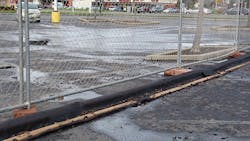About the author: For more information, email [email protected].
Shames Construction Co. of Livermore, Calif., recently was asked to convert a retail space located off Florin Road in Elk Grove, Calif., into a Walmart Neighborhood Market. Working on a site where the structure already is built has its advantages, but, as with any job, this site had more than a few problems to resolve.
The space for the new Walmart was located in an already developed strip mall. This presented several challenges when considering options for perimeter control BMPs. The storm water pollution prevention plan (SWPPP) initially called for approximately 1,000 ln ft of flexible sediment barrier. Due to Walmart’s rigorous SWPPP requirements, a traditional hard-surface BMP solution such as straw wattle and gravel bags was not an option. The original specification also called for a silt dike that required adhesive to install. The project managers were hesitant to apply the adhesive to the asphalt on the lot due to the inevitable damage it would cause upon removal. Additionally, the freight for the silt dike was cost-prohibitive.
After speaking with several erosion control suppliers, Shames decided to implement the DuraWattle, a product by Heavyweight Sediment Control Solutions, on the site.
Shames chose this product for several reasons. At the time, it shipped compressed 1,200 ft to a pallet (it now ships 1,800 ft to a pallet). Secondly, the installation only required tapcon screws and wood planks, and could easily be uninstalled without damage. Shames was especially attracted to the sediment barrier’s reusability.
Installation
Twelve hundred linear feet of the sediment barrier arrived on site. “It was well packaged and compact enough to be stored in a smaller storage section on site,” said Terry Sigler, project manager.
The fact that the DuraWattle ships compressed solved the freight issue the project was facing with the silt dike. Workers unloaded each 12-ft section and punctured the inner linings to inflate the barrier. Working in small sections, installers connected the interlocking sections and secured the wattle to the asphalt by folding the tail and anchoring it into place using inexpensive parts found at any hardware store. When asked about the difficulty of the installation process, Sigler said, “[It’s] more cost-effective than the glue. [You can] save some time not having to glue both sides: Just fold over your lap, pre-drill your holes, and run your tapcons in.”
Sigler also reported that it took approximately 22 man-hours to install about 1,000 ft of the DuraWattle on
the asphalt, and that it was lightweight and fairly easy to handle.
Performance
The day after a minor rain event, Sigler noted that all small bits of dirt and debris that had been carried up to the perimeter by water flow were held behind the barrier. As the water dispersed along the bottom of the wattle, the loose particles were filtered out. “The water flowed out to our drain inlets, and it worked great,” he said. Sigler found that once dry, the dirt and debris were easy to clean up. He also observed that there was an even drying pattern across the site, with no visible ponding or pooling.
Dean Hillyard, superintendent for Shames, stated that the project team had been using the DuraWattle in low-traffic areas of the site, where rumble plates were not required by Walmart (the wattle can be driven over in low or high traffic, but when placed on top of rumble plates, it does not hold up to being driven over). “We’ve had trucks drive over it, and it just bounces right back,” Hillyard said, adding that, although California received little rain in the first five months of the project, the wattle remained just as effective as when it was first installed on site. Hillyard also used a few extra sections creatively throughout the site where the water flow was greater during rain events.
Conclusion
After five months of use, the original Heavyweight DuraWattle was still effective at filtering sediments on site. During the job, it remained securely anchored to the ground and continued to rebound after being driven over. When asked what he liked most about this application of the DuraWattle, Hillyard said, “I don’t have to pay attention to it. [It is] very low maintenance. It does the job whether you’re there or not.” He noted that the DuraWattle is easy to keep in compliance.
Hillyard also plans to pick up and reuse the majority of the DuraWattle when the job is finished in June 2015. He plans to pack the 12-ft sections into a container for transport to the next job, whether for use on hard surface again, or for use on soil. Hillyard was happy about the transportability and storage possibilities with DuraWattle because the silt dike he was accustomed to was “big and bulky” to store. “But now, we can crunch [the DuraWattles] down and put them on a pallet and ship them from job to job.”
Download: Here


